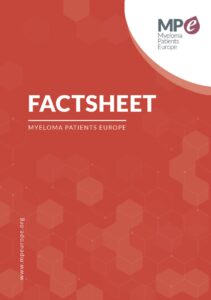What is carfilzomib (Kyprolis®)?
Carfilzomib is a cancer medicine approved in Europe in 2015 for the treatment of relapsed and/or refractory myeloma (i.e. myeloma that is not responding to previous treatment) in adult patients who have had at least one previous treatment cycle. It was approved for use in combination with lenalidomide and dexamethasone (KRd) or with dexamethasone alone (Kd).
As myeloma is considered a ‘rare disease’ because of the small number of patients with this disease, carfilzomib was granted ‘orphan drug designation’ by the European Commission in 2008. An orphan drug designation is a status assigned to medicines developed for rare disease conditions that affect fewer than 5 patients per 10,000 inhabitants in the EU.
How does carfilzomib work?
Carfilzomib is a proteasome inhibitor. It works by blocking the actions of proteasomes. Proteasomes are large molecules found in cells of the body, and they are involved in the breakdown of damaged or unwanted proteins. Proteasome inhibitors temporarily block their function, stopping them from breaking down unwanted proteins. This causes proteins to build up to toxic levels, killing the myeloma cell. Myeloma cells rely more heavily on proteasomes than normal healthy cells; they are therefore much more sensitive to proteasome inhibitors.
What are the benefits of carfilzomib?
Carfilzomib taken together with lenalidomide and dexamethasone (KRd) has been compared with lenalidomide plus dexamethasone (Rd) in a study involving 792 myeloma patients whose disease had got worse after previous treatment. Carfilzomib prolonged the average length of time before the patient’s disease got worse again (progression-free survival): patients receiving KRd lived for an average of 26.3 months without their disease getting worse, compared with 17.6 months for patients receiving only Rd. Patients in the study reported an improvement in overall health and quality of life without negatively affecting symptoms when taking KRd compared with Rd.
Another study in 929 multiple myeloma patients whose disease had got worse after previous treatment compared the combination of carfilzomib and dexamethasone with bortezomib and dexamethasone. The study showed that the combination of carfilzomib and dexamethasone is more effective at improving the time until the disease gets worse than bortezomib and dexamethasone. Patients receiving carfilzomib and dexamethasone lived for an average of 18.7 months without their disease getting worse, compared to 9.4 months for patients receiving bortezomib and dexamethasone.
What are the side effects of carfilzomib?
The most common side effects (which may affect more than one in five people) are1:
- tiredness
- anaemia (low red blood cell counts)
- nausea (feeling sick)
- thrombocytopaenia (low blood platelet counts)
- fever
- dyspnoea (difficulty breathing)
- diarrhoea
- respiratory tract infection
- cough
- neutropenia (low levels of neutrophils, a type of white blood cells)
- raised body temperature
- swollen ankles and feet
The most common serious side effects (affecting between one in 100 and one in 10 people or more) include toxic effects on the heart, lungs and liver, hypertension (high blood pressure), dyspnoea, thrombocytopaenia, acute kidney injury and infusion related reactions. Other uncommon or rare serious effects (affecting between one in 1,000 and one in 10,000 people) are tumour lysis syndrome (a complication due to the breakdown of cancer cells), internal bleeding, posterior reversible encephalopathy syndrome (a brain disorder that can cause headache, confusion, fits and loss of vision), thrombotic microangiopathy and TTP/HUS (diseases involving problems with the blood clotting system).
Who should not receive carfilzomib?
Carfilzomib must not be used in women who are breastfeeding. Women should avoid becoming pregnant and men should avoid fathering a child during treatment with carfilzomib.
How and when is carfilzomib given?
Carfilzomib is administered as an infusion at a hospital outpatient department or clinic, under the supervision of a doctor who specialises in the treatment of cancer. The starting dose is calculated using your height and weight. It may be increased if the medicine is well tolerated. Each infusion may last 10-30 minutes according to the dose. It is given on two consecutive days each week for three weeks followed by a week of rest. Each 28-day period is considered one treatment cycle.
Before starting carfilzomib, you should have a full medical work-up (including blood pressure and fluid management). You should be closely monitored during treatment. If you have severe side effects or the disease gets worse, treatment may need to be stopped or the dose reduced. Contact your doctor immediately if you have fever, chills, shivering, chest pain, cough, or swelling of the feet or legs, bleeding, bruising, weakness, headaches, confusion, seizures, or loss of sight.
References
- European Medicines Agency. Kyprolis (carfilzomib) European public assessment report (EPAR): https://www.ema.europa.eu/en/documents/overview/kyprolis-epar-medicine-overview_en.pdf. Last updated 03/2018
- Manufacturer’s product information https://www.kyprolis.eu/
- Stewart AK et al. Carfilzomib, Lenalidomide, and Dexamethasone for Relapsed Multiple Myeloma. N Engl J Med 2015;372:142–152
- Stewart AK et L. Health-Related Quality of Life Results From the Open-Label, Randomized, Phase III ASPIRE Trial Evaluating Carfilzomib, Lenalidomide, and Dexamethasone Versus Lenalidomide and Dexamethasone in Patients With Relapsed Multiple Myeloma. j Clin Oncol Published ahead of print September 6, 2016
- Dimopoulos MA et al. Carfilzomib and dexamethasone versus bortezomib and dexamethasone for patients with relapsed or refractory multiple myeloma (ENDEAVOR): a randomised, phase 3, open-label, multicentre study. Lancet Oncol 2016; 17:27-38.
- Rajkumar, SV and Kumar, S. Multiple Myeloma: diagnosis and treatment. Mayo Clin Proc 2016;91(1):101-119
